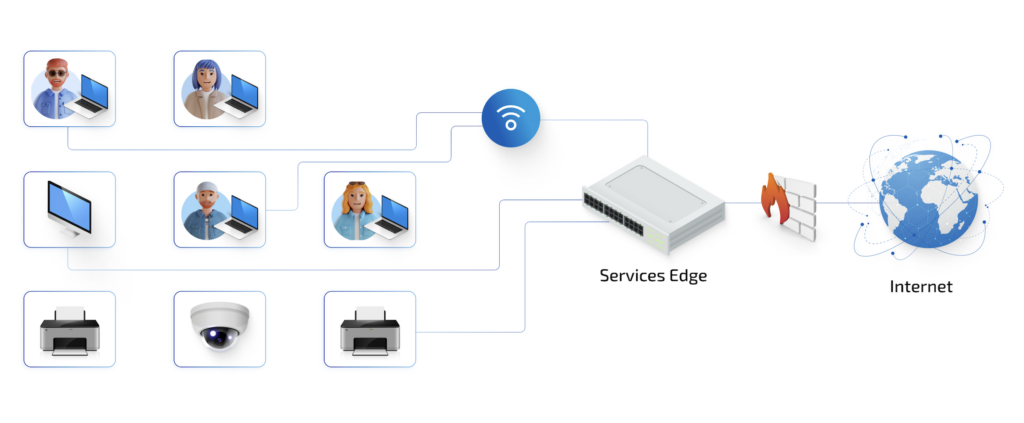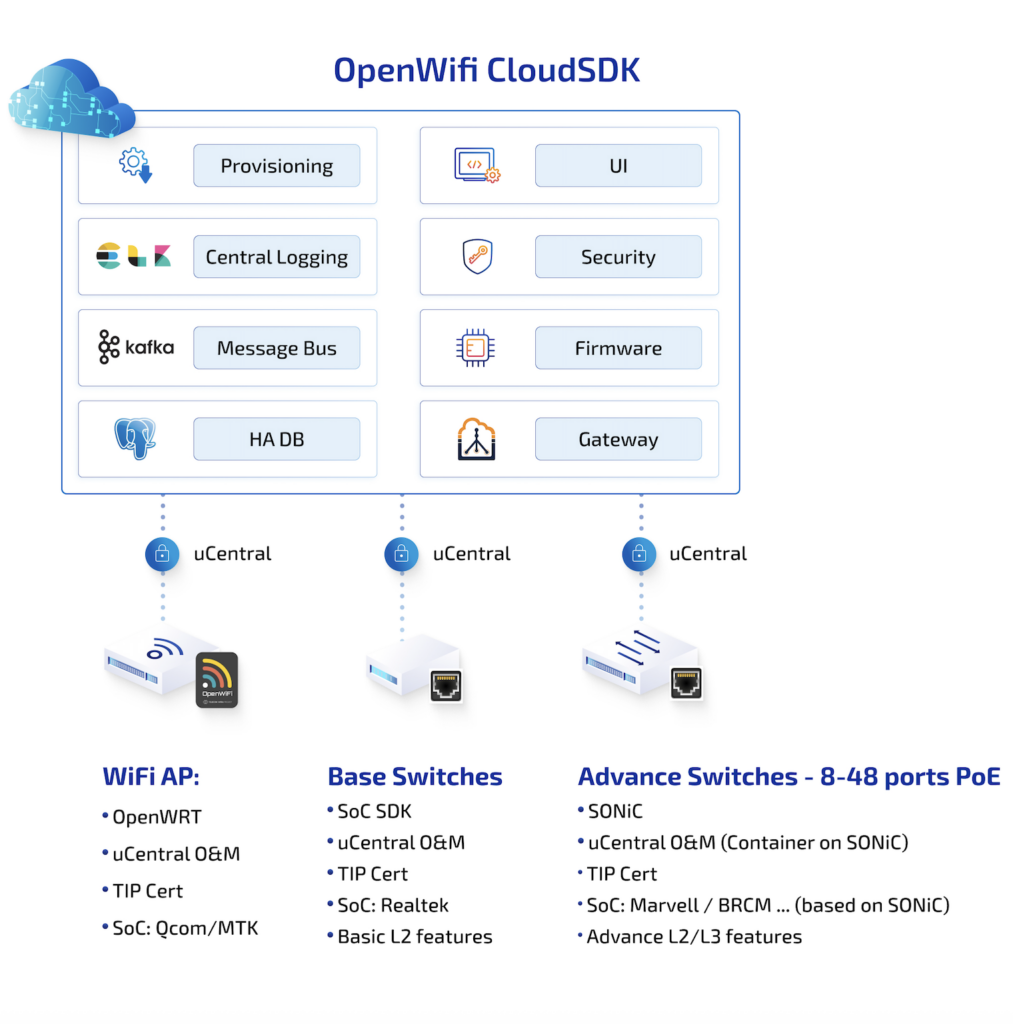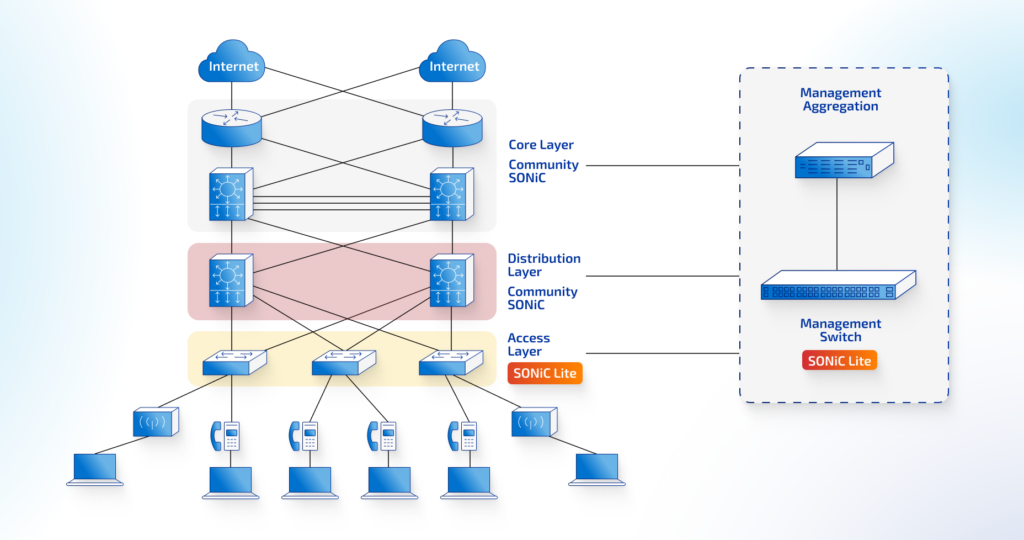Introduction
The Local Area Network as a Service (LANaaS) market is gaining serious momentum: valued at $8.5 billion in 2023 and projected to surpass $19.2 billion by 2032 according to the latest research. As modern businesses increasingly adopt service-based models, LANaaS has become a vital offering for organizations that require enterprise-grade, reliable, and scalable networks without heavy upfront investments or dedicated in-house IT teams.
As LANaaS providers strive to seize this growing market, they seek innovative solutions that deliver vendor neutrality, cost control and predictability, enhanced security, and the agility to provide customized, reliable network services.
This article examines the key challenges LANaaS providers face and demonstrates how open and disaggregated networking, powered by solutions like OpenLAN Switching (OLS) and SONiC-based network operating systems, meets these needs with game-changing advantages.
The Role of LANaaS Providers for Businesses
Modern businesses, especially those lacking dedicated IT teams, operate in environments where network demands can change rapidly. This highlights their need for quick solutions, specific functionalities, expertise, and cost savings compared to building their own infrastructure.
To keep up, they leverage LAN solutions that scale easily up or down based on fluctuating workloads and growth needs. Traditional, monolithic LAN architectures struggle to keep pace: they’re rigid, expensive, and cumbersome to manage across distributed locations. Consequently, LAN-as-a-Service providers deliver critical value, offering scalable, agile solutions tailored to modern enterprise requirements.

LANaaS transforms networking costs from capital to predictable operational expenses. Instead of investing in hardware refreshes and staff training, businesses subscribe to managed services with certified on-site hardware and cloud-based management for real-time monitoring, analytics, and automated updates. Tiered support ensures expert handling of installation, monitoring, security, and troubleshooting.
From SMBs to large enterprises across retail, education, healthcare, and government, LANaaS offers flexible, reliable, and cost-efficient enterprise-grade networks without the need for big IT teams.
LANaaS Use Cases & Delivered Value
Use Case:
Value Delivered:
Small and medium-sized businesses
Predictable monthly billing with fully outsourced management, and easy access to the network and its capabilities
Enterprises with multiple offices
Centralized control and uniform performance everywhere; connection between branches and integration into a single network; data transfer and storage; Wi-Fi
Educational campuses
On-demand capacity to handle peak usage, sometimes including audio and video transmission; Wi-Fi
Healthcare facilities
Secure, HIPAA-compliant access to patient data and transfer of patient data
Retail chains
Reliable POS systems and guest Wi-Fi; advertising broadcasts on LED screens and audio broadcast
Financial institutions
Advanced security for sensitive financial transactions
Government agencies
Turnkey network operations with strict compliance, data processing, and security requirements
Delivering and managing advanced LAN-as-a-Utility services is no simple task. Providers must navigate the requirements of modern network infrastructures, which is often a resource-heavy and technically demanding endeavor. Dependence on proprietary hardware and software can lead to vendor lock-in, driving up costs and limiting flexibility. Meanwhile, the rapid pace of technological advancement and the changing threats require constant reinvestment in expertise, feature upgrades, and innovation.
The Strategic Role & Benefits of Open and Disaggregated Networking for LANaaS Providers
Open and disaggregated networking offers a compelling alternative to proprietary solutions, helping LAN-as-a-Service providers address key challenges and seize new opportunities.
- Major advantages are cost optimization and predictability. By adopting open-source Network Operating Systems (NOS) like Community SONiC and disaggregated architectures, providers reduce licensing costs, minimize reliance on costly proprietary hardware, and improve long-term TCO, critical for maintaining competitive pricing and healthy margins.
- Open networking also ensures vendor independence and flexibility. By decoupling hardware and software, LANaaS providers can choose best-fit solutions, avoid vendor lock-in, and control their infrastructure strategy and pricing models.
- Solutions like OLS-integrated cloud management platforms, combining Cloud SDK, OpenWiFi, and SONiC, deliver an end-to-end, disaggregated environment with centralized orchestration, faster service deployment, and seamless cloud integration.
- Another key strength is customization. Open-source NOS platforms can be adapted to specific operational needs, integrated with existing systems, and enhanced through active global developer communities, an asset for providers aiming to differentiate and meet diverse customer demands.
In summary, open networking offers LANaaS companies a flexible, cost-effective, and future-ready approach to network infrastructure, empowering them to innovate, scale, and deliver superior service experiences.
The Most Common Scenarios for Integrating Open Networking Technologies
While open networking technologies offer clear benefits, building LAN networks with open-source solutions can present challenges in various scenarios. Several approaches can be considered:
- Implement ready-to-deploy licensed solutions
- Develop a custom solution tailored to your use case and requirements
- Leverage hardened open-source images for your network infrastructure
By choosing the path of open-source technologies, here are some of the most popular options for the LAN network infrastructures:
- OpenLAN Switching (OLS): A comprehensive networking solution that integrates OpenWiFi systems with powerful PoE switches.
- Software for Open Networking in the Cloud (SONiC): A Linux-based network operating system (NOS) that runs on switches from multiple vendors and ASIC platforms, unifies hardware and cloud management.
OpenLAN Switching (OLS): Use Cases and Cloud Integration
OpenLAN Switching (OLS) is a Telecom Infra Project (TIP) initiative that brings an open, cloud-native approach to network infrastructure. Building on the success of OpenWiFi, OLS tackles the demands of modern networks:
- OLS-powered switches deliver PoE++ to next-generation 6 GHz access points, providing the high power and bandwidth needed to support Wi-Fi 6E/7 and ensure seamless wireless performance.
- Unified Cloud Management through a CloudSDK controller backend enables centralized configuration, monitoring, and troubleshooting of both Wi-Fi and switch infrastructure from a single interface.
- OLS is optimized for low-latency, high-bandwidth applications such as AR/VR, real-time collaboration, and other demanding workloads, delivering the performance today’s enterprises require.
On the edge, the uCentral client abstracts hardware differences and enables secure zero-touch provisioning (ZTP) over the public internet. This unified, cloud-centric workflow removes the headaches of managing siloed systems, boosting efficiency and scale for millions of commercial buildings worldwide.

TIP’s OLS community has validated a comprehensive blueprint for open, interoperable LAN solutions:
- The hardware base features a diverse range of 8 to 48-port white-box switches from vendors like Wistron and Edgecore, built on Broadcom Trident 3 and Marvell silicon.
- The software stack includes a SONiC-based switch image tailored for wiring-closet deployments, integrating 802.1X authentication, advanced PoE management, and scalable IP fabrics.
- The Cloud Controller, powered by CloudSDK, unifies device configuration, telemetry, and operations into a single, hardened end-to-end system.
Within the TIP ecosystem, Candela Labs offers fully tested and validated OLS configurations for a wide spectrum of networking equipment, from enterprise APs to high-density switches. Each OLS setup is rigorously proven in both lab and live campus environments. This validation is backed by Candela Technologies’ Wi-Fi Testing Services, which include functional and performance testing, stress and stability assessments, regulatory/TR-398 compliance, OpenWiFi and IoT device validation, CI/CD automation, and large-scale real-world use cases.
Aligning SONiC NOS with LAN-as-a-Service Providers Business Needs
SONiC NOS is a core pillar of this blueprint (alongside the hardware base and CloudSDK), providing the open-source NOS foundation that unifies hardware and cloud management. Depending on your resources and objectives, LANaaS company has several options:
Custom SONiC-Based Distribution
A fully custom solution offers maximum flexibility, allowing you to tailor SONiC to your use case and add new features. While powerful, SONiC’s complexity requires an experienced in-house team for customization and maintenance. Opting for a tailored SONiC over proprietary NOS ensures cost efficiency, vendor neutrality, and freedom from subscription fees. It supports high-speed switching (100G/400G/800G), advanced protocols (BGP, VXLAN, EVPN), and seamless multi-vendor hardware integration — granting full infrastructure ownership, cost control, and agile scalability.
Hardened Community SONiC Image
Enhance cost-efficiency and vendor neutrality by adopting a hardened Community SONiC image. This involves testing its stability and performance against your workloads to confirm alignment with current and future needs, ensuring a smooth transition from evaluation to production.
Ready-to-Use SONiC Distribution
For DC, edge, or campus use, a ready-to-deploy SONiC Lite distribution may be ideal, offering a cost-effective licensed option for essential networking. Its vendor-neutral design supports a broad, expanding range of switches via an actively growing Hardware Compatibility List (HCL), ensuring interoperability, flexibility, and investment protection.

Despite its lightweight design, SONiC Lite retains the essential functionalities of the Community SONiC, including Layer 2 switching, Layer 3 routing, and comprehensive security features. It integrates critical additional functionalities such as xSTP, OLS, and RADIUS, Port-based Network Access Control (PNAC), and PoE++ capabilities. Additionally, you can purchase a source-based license, giving you full ownership of the distribution and the freedom to customize it for your needs.
On top of that, we provide continuous support and training to ensure your team climbs the learning curve quickly and manages your deployment with confidence.
A trusted technology partner like PLVision unlocks the full potential of open and disaggregated networking, delivering end-to-end, vendor-agnostic solutions tailored to specific use cases.
Conclusion
Open-source technologies have matured enough to reliably support modern network infrastructure and enable LAN-as-a-Service offerings. The shift to open networking provides LANaaS providers with a clear, sustainable path to long-term cost optimization and predictability, vendor independence, and faster time-to-market through flexible, feature-rich network infrastructures that address a wide range of customer needs.
By leveraging PLVision’s deep expertise and dedicated support, you can tailor open and disaggregated networking solutions to your unique operational requirements, seamlessly integrate with existing management systems, and confidently roll out new services with greater control.



